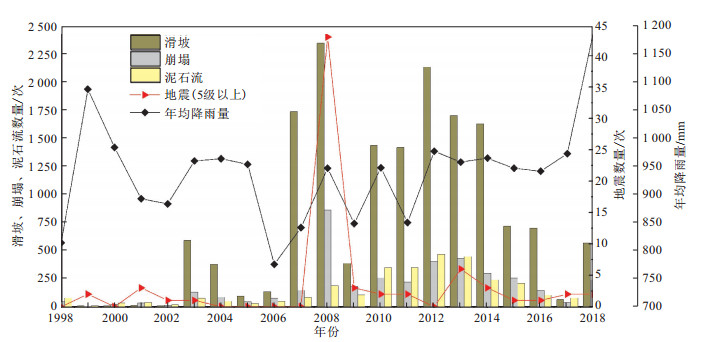Spatio-temporal development characteristics of major geohazards in Sichuan Province around "5·12" Wenchuan earthquake
-
摘要: 区域地质灾害时空发育规律是内外地质营力共同作用的结果,大区域范围内外地质营力相对稳定,因此,地震的震源、震级、发生时间是影响大区域地质灾害时空发育规律的主要因素。为研究"5·12"汶川地震对四川省地质灾害时空发育的影响,以1998-2018年滑坡、崩塌、泥石流、地震、降雨等数据为基础,采用数理统计与空间分析方法对比分析了汶川地震前后四川省主要地质灾害时空特征,结果表明:①四川省主要地质灾害的活跃性呈周期变化,正常情况下呈现3 a左右的小周期,"5·12"地震后地质灾害逐年增强,4 a达到峰值,之后逐年减弱,8 a后其影响不明显;②主要地质灾害发生的相对强度地震后变化不大,但较震前在各类型分区所表现的地质灾害活力与强度不对应,地貌分区中地灾数量最多的为四川盆地,而地灾活力最强的为川西北高原;岩性分区上震后地灾易发性与震前相比较第四系高于坚硬岩区;构造分区上地质灾害具有明显的分区特征,地震前后扬子准地台发生的地灾强度均远远大于松潘-甘孜地槽褶皱系,但地灾活力明显弱于松潘-甘孜地槽褶皱系,基本构造单元也有类似的特点。
-
关键词:
- “5·12”汶川地震 /
- 地质灾害 /
- 时空发育 /
- 地灾强度 /
- 地灾活力
Abstract: The temporal and spatial development law of regional geohazards is the result of the joint action of internal and external geological forces, which are relatively stable within a large area. Therefore, the source, magnitude and occurrence time of earthquakes are the main factors affecting the temporal and spatial development law of regional geohazards. In order to study the impact of "5·12" Wenchuan earthquake on the spatial and temporal development of geohazards in Sichuan Province, based on the data of landslide, collapse, debris flow, earthquake and rainfall from 1998 to 2018, the spatial and temporal characteristics of major geohazards in Sichuan Province around the Wenchuan earthquake were analyzed by mathematical statistics and spatial analysis methods, The results show that: ① Activity in major disasters in Sichuan Province shows cycles, under normal circumstances, it presents a small cycle of about 3 years, after the earthquake geohazards increased year by year, to the peak of 4a, then decreased year by year; the impact is not obvious after 8 years; ② The relative intensity of major geohazards has little change after the earthquake, but the activity and intensity of geohazards are not corresponding before the earthquake. In the geomorphic division, the largest number of geohazards is in Sichuan Basin, and the most active is in Northwest Sichuan Plateau. Compared with that before the earthquake, the occurrence of geohazards in the quaternary system is higher than that in the hard rock area. The geohazards in the tectonic zones have obvious zoning characteristics. The earthquake intensity of the Yangtze quasi-platform is much greater than that of the Songpan-Ganzi geosynclinal fold system before and after the earthquake, but the disaster activity is obviously weaker than that of the Songpan-Ganzi geosynclinal fold system, and the basic structural units have similar characteristics. -
表 1 四川省地质灾害岩性分区
Table 1. Lithologic division of geological hazards in Sichuan Province
岩性分区 特点 第四系 残积、坡积、松散沉积物 坚硬岩区 厚层状砂岩组
中-厚层状灰岩及白云岩组
块状玄武岩组
整体状花岗岩组较坚硬岩区 中-厚层状砂岩夹砾岩、泥岩组
厚层状砂岩夹板岩岩组
中-厚层状弱岩溶化灰岩、泥质灰岩岩组
薄-中厚层状砂岩与板岩互层岩组
中-厚层状板岩夹泥质灰岩、砂岩、火山岩岩组软弱-较坚硬岩区 层状砂、泥质及砾泥岩互层岩组
薄层状泥、页岩岩组
薄-中厚层状千枚岩、片岩夹灰岩、砂岩岩组
薄-中厚层状千枚岩、片岩夹火山岩、火山碎屑岩岩组软硬相间岩区 中-厚层状砂、泥质互层岩组
薄-中厚层状砂、泥岩夹灰岩、泥质灰岩岩组
中-厚层状中等岩溶化灰岩、白云岩夹砂、泥岩岩组
中-厚层状弱岩溶化灰岩、白云质灰岩夹千枚岩、板岩岩组
薄-中厚层状板岩、千枚岩与变质砂岩互层岩组块状英安斑岩夹火山碎屑岩岩组表 2 各构造单元地震前后地质灾害统计
Table 2. Statistics of geological disasters before and after earthquakes in each structural unit
Ⅰ级构造区 Ⅱ级构造区 Ⅲ级构造区(基本构造单元) 震前 震后 滑坡/起 崩塌/起 泥石流/起 滑坡/起 崩塌/起 泥石流/起 Ⅰ1扬子准地台 Ⅱ1康滇地轴 71 11 55 558 20 161 Ⅱ2盐源-丽江台缘坳陷褶断带 8 0 5 14 3 27 Ⅱ3龙门山台缘坳陷褶断带 9 10 7 276 142 467 Ⅱ4米仓山合隆 39 14 3 313 30 17 Ⅱ5山台缘坳陷褶断带 56 7 2 220 19 9 Ⅱ6上扬子台褶带 Ⅲ1瓦山-峨眉山断块 18 5 6 41 19 36 Ⅲ2凉山褶束 47 5 32 243 20 145 Ⅲ3大娄山褶束 22 13 1 87 31 18 Ⅱ7四川台拗 Ⅲ4川西台坳 167 45 13 1 123 293 244 Ⅲ5川北台坳 818 57 4 2 616 366 19 Ⅲ6川中台拱 549 174 8 2 218 626 40 Ⅲ7川东褶束 1 012 111 21 1 545 313 37 Ⅰ2松潘-甘孜地槽褶皱系 Ⅱ8巴颜喀拉冒地槽褶皱带 Ⅲ8摩天岭地背斜 1 0 5 77 22 86 Ⅲ9后龙门山地背斜 21 11 67 344 169 510 Ⅲ10里伍地背斜 3 3 10 8 5 40 Ⅲ11若尔盖中间地块 0 0 2 13 0 21 Ⅲ12马尔康地向斜 5 2 17 113 36 147 Ⅲ13炉霍-乾宁地背斜 0 0 4 5 2 30 Ⅲ14石渠-雅江地向斜 1 0 9 29 17 39 Ⅱ9沙鲁里山优地槽褶皱带 Ⅲ15中咱地背斜 1 0 4 8 2 54 Ⅲ16甘孜-木里地背斜 4 0 2 19 16 29 Ⅲ17义郭地向斜 0 0 2 7 2 52 Ⅰ3秦岭地槽褶皱系 53 4 0 178 13 9 Ⅰ4三江地槽褶皱系 1 0 0 0 0 10 -
[1] 黄润秋. "5·12"汶川大地震地质灾害的基本特征及其对灾后重建影响的建议[J]. 中国地质教育, 2008(2): 21-24. doi: 10.3969/j.issn.1006-9372.2008.02.007Huang R Q. Characteristics of geological disasters of "5·12" Wenchuan earthquake and recommendation on its impact on reconstruction[J]. Chinese Geological Education, 2008(2): 21-24(in Chinese with English abstract). doi: 10.3969/j.issn.1006-9372.2008.02.007 [2] 何宏林, 孙昭民, 王世元, 等. 汶川M_S8.0地震地表破裂带白沙河破裂及其位移特征[J]. 地震地质, 2008, 30(2): 359-362. https://www.cnki.com.cn/Article/CJFDTOTAL-DZDZ200803006.htmHe H L, Sun Z M, Wang S Y, et al. Rupture and displacement characteristics of Baisha reach in surface rupture zone of Wenchuan M_S8.0 earthquake[J]. Seismic Geology, 2008, 30(2): 21-24(in Chinese with English abstract). https://www.cnki.com.cn/Article/CJFDTOTAL-DZDZ200803006.htm [3] 滕骥, 吕玉娟, 冯自兴, 等. 汶川地震序列早期特征及成因分析与探究[J]. 化工管理, 2018(36): 146-147. doi: 10.3969/j.issn.1008-4800.2018.36.100Teng J, Lv Y J, Feng Z X, et al. Analysis and exploration of the early features and causes of Wenchuan earthquake[J]. Chemical Enterprise Management, 2018(36): 146-147(in Chinese with English abstract). doi: 10.3969/j.issn.1008-4800.2018.36.100 [4] 孙艳萍, 张苏平, 陈文凯, 等. 汶川地震滑坡危险性评价: 以武都区和文县为例[J]. 地震工程学报, 2018, 40(5): 1084-1091. doi: 10.3969/j.issn.1000-0844.2018.05.1084Sun Y P, Zhang S P, Chen W K, et al. Risk assessment of landslides caused by Wenchuan earthquake: A case study in the Wudu district and Wenxian County, Gansu Province[J]. China Earthquake Engineering Journal, 2018, 40(5): 1084-1091(in Chinese with English abstract). doi: 10.3969/j.issn.1000-0844.2018.05.1084 [5] 王东坡, 何思明, 葛胜锦, 等. "9·07"彝良地震诱发次生山地灾害调查及减灾建议[J]. 山地学报, 2013, 31(1): 101-107. doi: 10.3969/j.issn.1008-2786.2013.01.014Wang D P, He S M, Ge S J, et al. Mountain hazards induced by the earthquake of Sep 07, 2012 in Yiliang and the suggestions of disaster reduction[J]. Mountain Research, 2013, 31(1): 101-107(in Chinese with English abstract). doi: 10.3969/j.issn.1008-2786.2013.01.014 [6] 黄润秋, 李为乐. "5·12"汶川大地震触发地质灾害的发育分布规律研究[J]. 岩石力学与工程学报, 2008, 27(12): 2585-2592. doi: 10.3321/j.issn:1000-6915.2008.12.028Huang R Q, Li W L. Research on development and distribution rules of geo-hazards induced by Wenchuan earthquake on 12th May, 2008[J]. Chinese Journal of Rock Mechanics and Engineering, 2008, 27(12): 2585-2592(in Chinese with English abstract). doi: 10.3321/j.issn:1000-6915.2008.12.028 [7] 梁京涛, 王军, 汪友明, 等. 汶川8.0级地震触发地质灾害发育分布规律研究[J]. 灾害学, 2015, 30(1): 63-68. doi: 10.3969/j.issn.1000-811X.2015.01.013Liang J T, Wang J, Wang Y M, et al. Development and distribution rules of geohazards induced by Wenchuan Ms8.0 earthquake[J]. Journal of Catastrophology, 2015, 30(1): 63-68(in Chinese with English abstract). doi: 10.3969/j.issn.1000-811X.2015.01.013 [8] 许冲, 戴福初, 陈剑, 等. 汶川Ms8.0地震重灾区次生地质灾害遥感精细解译[J]. 遥感学报, 2009, 13(4): 754-762. https://www.cnki.com.cn/Article/CJFDTOTAL-YGXB200904031.htmXu C, Dai F C, Chen J, et al. Remote sensing and detailed interpretation of secondary geological disasters in Wenchuan Ms8.0 earthquake stricken areas[J]. Journal of Remote Sensing, 2009, 13(4): 754-762(in Chinese with English abstract). https://www.cnki.com.cn/Article/CJFDTOTAL-YGXB200904031.htm [9] Fan X M, Scaringi G, Korup O, et al. Earthquake-induced chains of geologic hazards: Patterns, mechanisms, and impacts[J]. Rev. Geophys., 2019, 57(2): 421-503. doi: 10.1029/2018RG000626 [10] 韩金良, 吴树仁, 何淑军, 等. 5·12汶川8级地震次生地质灾害的基本特征及其形成机制浅析[J]. 地学前缘, 2009, 16(3): 306-326. doi: 10.3321/j.issn:1005-2321.2009.03.025Han J L, Wu S R, He S J, et al. Basal characteristics and formation mechanisms of geological hazards triggered by the May 12, 2008 Wenchuan earthquake with a moment magnitude of 8.0[J]. Earth Science Frontiers, 2009, 16(3): 306-326(in Chinese with English abstract). doi: 10.3321/j.issn:1005-2321.2009.03.025 [11] 黄润秋, 李前银, 叶晓华, 等. 都江堰-汶川公路汶川地震次生地质灾害主要特征和形成机理[J]. 地质力学学报, 2010, 16(2): 146-158. doi: 10.3969/j.issn.1006-6616.2010.02.005Huang R Q, Li Q, Ye X H, et al. Formation mechanism of geo-hazards triggered by Wenchuan MS8.0 earthquake along Dujiangyan-Wenchuan highway[J]. Journal of Geomechanics, 2010, 16(2): 146-158(in Chinese with English abstract). doi: 10.3969/j.issn.1006-6616.2010.02.005 [12] 胡涛. 汶川震区震后大型泥石流致灾机理及防治对策研究[D]. 成都: 成都理工大学, 2017.Hu T. The research on formation mechanism and mitigation measure of large-scale debris flow in the Wenchuan earthquake area[D]. Chengdu: Chengdu University of Technology, 2017(in Chinese with English abstract). [13] 许强. 四川省8·13特大泥石流灾害特点、成因与启示[J]. 工程地质学报, 2010, 18(5): 596-608. doi: 10.3969/j.issn.1004-9665.2010.05.002Xu Q. The 13 August 2010 catastrophic debris flows in Sichuan Province: Characteristics, genetic mechanism and suggestions[J]. Journal of Engineering Geology, 2010, 18(5): 596-608(in Chinese with English abstract). doi: 10.3969/j.issn.1004-9665.2010.05.002 [14] 唐川, 铁永波. 汶川震区北川县城魏家沟暴雨泥石流灾害调查分析[J]. 山地学报, 2009, 27(5): 625-630. doi: 10.3969/j.issn.1008-2786.2009.05.017Tang C, Tie Y B. Reconnaissance and analysis on the rainstorm induced debris flow in Weijiagou valley of Beichuan City after the Wenchuan earthquake[J]. Mountain Research, 2009, 27(5): 625-630(in Chinese with English abstract). doi: 10.3969/j.issn.1008-2786.2009.05.017 [15] 黄润秋, 裴向军, 李天斌. 汶川地震触发大光包巨型滑坡基本特征及形成机理分析[J]. 工程地质学报, 2008, 16(6): 730-741. doi: 10.3969/j.issn.1004-9665.2008.06.002Huang R Q, Pei X J, Li T B. Basic characteristics and formation mechanism of the largest scale landslide at Daguangbao occurred during the Wenchuan earthquake[J]. Journal of Engineering Geology, 2008, 16(6): 730-741(in Chinese with English abstract). doi: 10.3969/j.issn.1004-9665.2008.06.002 [16] 黄润秋. 汶川地震地质灾害后效应分析[J]. 工程地质学报, 2011, 19(2): 145-151. doi: 10.3969/j.issn.1004-9665.2011.02.001Huang R Q. After effect of geohazards induced by the Wenchuan earthquake[J]. Journal of Engineering Geology, 2011, 19(2): 145-151(in Chinese with English abstract). doi: 10.3969/j.issn.1004-9665.2011.02.001 [17] 高会会, 裴向军, 崔圣华, 等. 汶川震区震后地质灾害发育分布及演化特征统计分析[J]. 长江科学院院报, 2019, 36(8): 73-80. https://www.cnki.com.cn/Article/CJFDTOTAL-CJKB201908015.htmGao H H, Pei X J, Cui S H, et al. Geological hazards after earthquake in Wenchuan earthquake area: Distribution and evolvement features[J]. Journal of Yangtze River Scientific Research Institute, 2019, 36(8): 73-80(in Chinese with English abstract). https://www.cnki.com.cn/Article/CJFDTOTAL-CJKB201908015.htm [18] 杨志华, 兰恒星, 张永双, 等. 强震区震后地质灾害长期活动性研究综述[J]. 地质力学学报, 2017, 23(5): 743-753. doi: 10.3969/j.issn.1006-6616.2017.05.011Yang Z H, Lan H X, Zhang Y S, et al. Research review on long-term activity of post-earthquake geo-hazards in strong seismic-disturbed regions[J]. Journal of Geomechanics, 2017, 23(5): 743-753(in Chinese with English abstract). doi: 10.3969/j.issn.1006-6616.2017.05.011 [19] Zhou W, Tang C. Rainfall thresholds for debris flow initiation in the Wenchuan earthquake-stricken area, southwestern China[J]. Landslides, 2014(5): 877-887. doi: 10.1007/s10346-013-0421-5 [20] 师皓宇, 马念杰. 龙门山断裂带及附近区域地貌形成与地应力演化机制研究[J]. 地震学报, 2018, 40(3): 332-340. https://www.cnki.com.cn/Article/CJFDTOTAL-DZXB201803008.htmShi H Y, Ma N J. Geomorphic formation and crustal stress evolution mechanism in the Longmenshan fault zone and its adjacent regions[J]. Acta Seismologica Sinica, 2018, 40(3): 332-340(in Chinese with English abstract). https://www.cnki.com.cn/Article/CJFDTOTAL-DZXB201803008.htm [21] 唐川, 马国超. 基于地貌单元的小区域地质灾害易发性分区方法研究[J]. 地理科学, 2015, 35(1): 91-98. https://www.cnki.com.cn/Article/CJFDTOTAL-DLKX201501011.htmTang C, Ma G C. Study on the method of small area geological disaster susceptibility zoning based on geomorphic unit[J]. Scientia Geographica Sinica, 2015, 35(1): 91-98(in Chinese with English abstract). https://www.cnki.com.cn/Article/CJFDTOTAL-DLKX201501011.htm [22] 宁珂, 王石英. 基于GIS、RS的四川省地貌区划[J]. 云南地理环境研究, 2018, 30(3): 47-54. doi: 10.3969/j.issn.1001-7852.2018.03.007Ning K, Wang S Y. A study of geomorphological regionalization of Sichuan using GIS and RS[J]. Yunnan Geographic Environment Research, 2018, 30(3): 47-54(in Chinese with English abstract). doi: 10.3969/j.issn.1001-7852.2018.03.007 [23] 徐志文. 四川省地质环境状况及地质灾害发育特征研究[J]. 地质与勘探, 2006, 42(4): 97-102. doi: 10.3969/j.issn.0495-5331.2006.04.021Xu Z W. Proposing the frame and measures for prevention and cure system of geological disasters in Sichuan Province[J]. Geology and Exploration, 2006, 42(4): 97-102(in Chinese with English abstract). doi: 10.3969/j.issn.0495-5331.2006.04.021 [24] 张怡悦, 殷坤龙, 陈丽霞, 等. 奉节县曾家棚滑坡时空差异性变形特征与成因机制分析[J]. 地质科技通报, 2020, 39(2): 148-157. https://dzkjqb.cug.edu.cn/CN/abstract/abstract9984.shtmlZhang Y Y, Yin K L, Chen L X, et al. Characteristics and mechanism of spatio-temporal difference of Zengjiapeng landslide[J]. Bulletin of Geological Science and Technology, 2020, 39(2): 148-157(in Chinese with English abstract). https://dzkjqb.cug.edu.cn/CN/abstract/abstract9984.shtml [25] 祝俊华, 陈志新, 祝艳波. 延安市滑坡分布规律及发育特征[J]. 地质科技情报, 2017, 36(2): 236-243. https://www.cnki.com.cn/Article/CJFDTOTAL-DZKQ201702031.htmZhu J H, Chen Z X, Zhu Y B. Distribution regularity and development characteristics of landslides in Yan'an[J]. Geological Science and Technology Information, 2017, 36(2): 236-243(in Chinese with English abstract). https://www.cnki.com.cn/Article/CJFDTOTAL-DZKQ201702031.htm [26] 郭晨, 许强, 魏勇, 等. 陕西泾阳南塬多序次黄土滑坡演化特征及成灾模式[J]. 地质科技情报, 2019, 38(5): 204-211. https://www.cnki.com.cn/Article/CJFDTOTAL-DZKQ201905022.htmGuo C, Xu Q, Wei Y, et al. Evolution characteristics and disaster modes of repeatedly failure loess landslides in southern Jingyang Plateau, Shanxi Province[J]. Geological Science and Technology Information, 2019, 38(5): 204-211(in Chinese with English abstract). https://www.cnki.com.cn/Article/CJFDTOTAL-DZKQ201905022.htm [27] 余斌, 马煜, 张健楠, 等. 汶川地震后四川省都江堰市龙池镇群发泥石流灾害[J]. 山地学报, 2011, 29(6): 738-746. doi: 10.3969/j.issn.1008-2786.2011.06.014Yu B, Ma Y, Zhang J N, et al. The group debris flow hazards after the Wenchuan earthquake in Longchi, Dujiangyan, Sichuan Province[J]. Mountain Research, 2011, 29(6): 738-746(in Chinese with English abstract). doi: 10.3969/j.issn.1008-2786.2011.06.014 [28] 柳万里, 晏鄂川, 戴航, 等. 南漳保康两县碳酸盐岩崩塌发育特征及影响程度分区[J]. 地质科技通报, 2020, 39(2): 104-112. https://dzkjqb.cug.edu.cn/CN/abstract/abstract9979.shtmlLiu W L, Yan E C, Dai H, et al. Development characteristics and influence degree zoning of carbonate rock collapse in Nanzhang and Baokang counties[J]. Bulletin of Geological Science and Technology, 2020, 39(2): 104-112(in Chinese with English abstract). https://dzkjqb.cug.edu.cn/CN/abstract/abstract9979.shtml [29] Yu B, Wu Y F, Chu S M. Preliminary study of the effect of earthquakes on the rainfall threshold of debris flows[J]. Engineering Geology, 2014, 182: 130-135. doi: 10.1016/j.enggeo.2014.04.007 [30] 赵友年, 陈斌. 四川省主要构造单元及其特征[J]. 四川地质学报, 2009, 29(增刊2): 88-94. https://www.cnki.com.cn/Article/CJFDTOTAL-SCDB2009S2016.htmZhao Y N, Chen B. Major tectonic elements and their features in Sichuan Province[J]. Acta Geologica Sichuan, 2009, 29(S2): 88-94(in Chinese with English abstract). https://www.cnki.com.cn/Article/CJFDTOTAL-SCDB2009S2016.htm [31] 甘芬芳, 徐刚, 徐羽, 等. 基于GIS的构造单元地震空间分形研究: 以四川省和重庆市为例[J]. 西南师范大学学报: 自然科学版, 2015, 40(6): 80-84. https://www.cnki.com.cn/Article/CJFDTOTAL-XNZK201506015.htmGan F F, Xu G, Xu Y, et al. On seismic spatial fractal research of tectonic units based on GIS: Taking Sichuan Province and Chongqing Municipality as an example[J]. Journal of Southwest China Normal University: Natural Science Edition, 2015, 40(6): 80-84(in Chinese with English abstract). https://www.cnki.com.cn/Article/CJFDTOTAL-XNZK201506015.htm [32] 蒋锋云, 朱良玉, 李玉江. 基于三维粘弹性有限元研究汶川地震对川滇地区的震后影响[J]. 地震研究, 2018, 41(2): 233-243, 343. doi: 10.3969/j.issn.1000-0666.2018.02.011Jiang F Y, Zhu L Y, Li Y J. Study of the co-seimsic and post-seimsic deformation deduced by the Wenchuan earthquake in the Sichuan-Yunnan region by three dimensional viscoelastic finite element model[J]. Journal of Seismological Research, 2018, 41(2): 233-243, 343(in Chinese with English abstract). doi: 10.3969/j.issn.1000-0666.2018.02.011 [33] Fan X M, Xu Q, Cees J V W, et al. Characteristics and classification of landslide dams associated with the 2008 Wenchuan earthquake[J]. Geoenvironmental Disasters, 2017, 4(1): 1-12. doi: 10.1186/s40677-016-0065-6 -





 下载:
下载:








